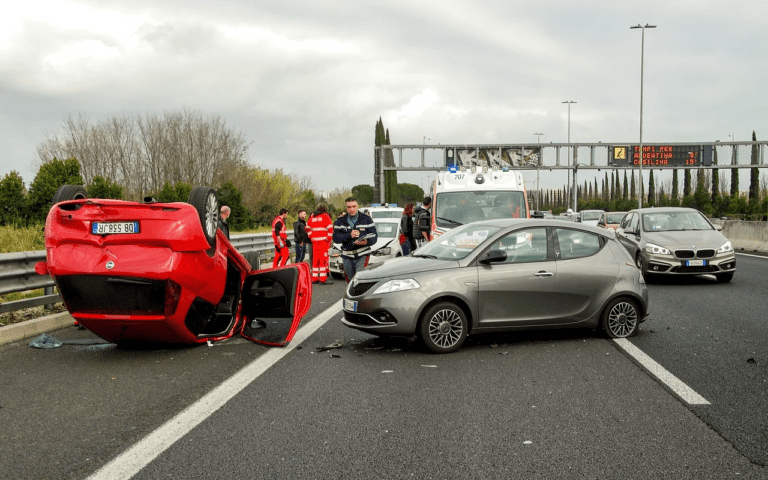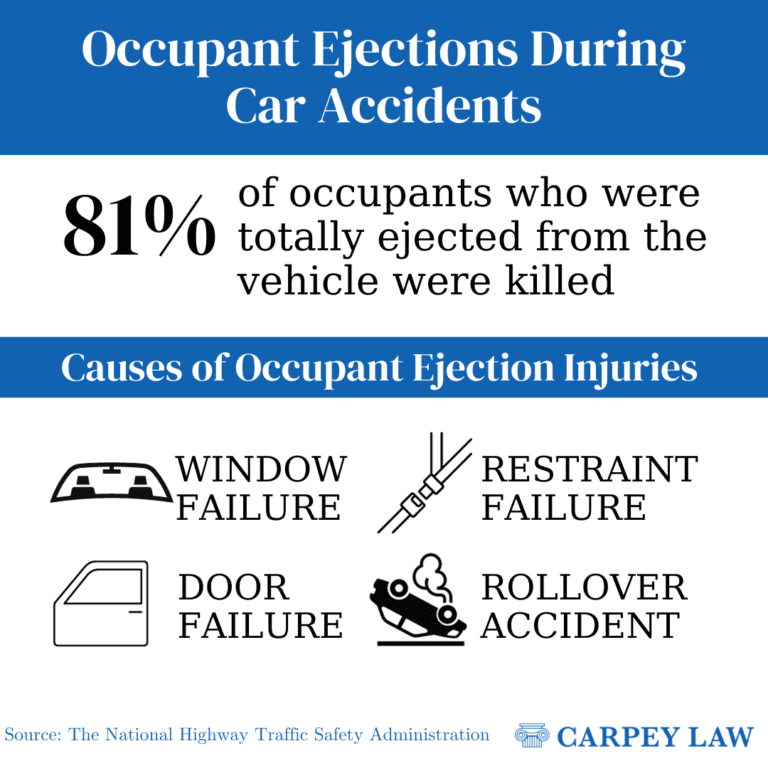An occupant ejection is one of the most traumatic outcomes of a car accident in Pennsylvania. Upon impact, the driver or passenger of the car involved in the accident is literally ejected from the vehicle, most often through the windshield. Occupant ejection accidents are particularly notable because of their fatality rate: The National Highway Traffic Safety Administration Reports that around 81 percent of occupants who were totally ejected from the vehicle upon impact were killed either during the accident or shortly after.
Different Types of Occupant Ejection Related To Car Accident
There are two types of occupant ejections, partial occupant ejection and full occupant ejection.
Full Occupant Ejection. A full occupant ejection occurs when a driver or passenger is thrown entirely from the vehicle, often landing in the road ahead or to the side.
Partial Occupant Ejection. A partial occupant ejection is when the driver or passenger of the vehicle is hanging from the car, usually through one of the side windows or the windshield.
While both forms of ejection are highly dangerous, a partial occupant ejection has slightly lower death rates.
What Causes Occupant Ejection Injuries From Car Accidents in Pennsylvania?
In the event of a car accident there are four main components which may cause an occupant ejection related to car accident injuries, door failure, window failure, restraint failure, and a rollover accident.
Door Failure
There are accident situations in which a door malfunction contributes to the ejection of a driver or passenger. Most often, the door of the car was not closed all the way or the latch on the door was faulty and opened upon impact. In such a situation, a vehicle occupant can easily fall from the car.
Window Failure
Windows are necessary for many reasons, some more obvious than others. A side window or windshield protects vehicle occupants from wind and debris while the car is in motion. However, in the event of an accident, a window can keep a passenger or driver in the car. If a window is damaged in some way prior to the accident, or if it is simply shattered during the crash, an occupant is more vulnerable to ejection.
Restraint Failure
Seatbelt failure is the number one cause of occupant ejection accidents in the US. And this includes a device malfunction as well as situations in which occupants failed to even use a seatbelt. It’s been reported that the use of a seatbelt can reduce a vehicle occupant’s chance of being fatally ejected by 45 percent and reduces the risk of serious injury by 50 percent.
Rollover Accident
These are one of the most fatal accidents occurring in the US. One of the reasons why rollover accidents in Pennsylvania can be so fatal is because they often result in occupant ejections. In fact, more than half of fatalities caused by rollover accidents involved the ejection of an occupant.
A roll over car accident is up there with the worst crashes a car accident lawyer in Philadelphia sees in his or her work. On average, these types of accidents only represent about 3 percent of annual car accidents. However, despite low rates of occurrence, roll over accidents play a role in 20 percent of annual car accident injuries and fatalities.
The Facts About Roll Over Car Accidents
Statistically, larger automobiles (such as SUVs, pickup trucks, vans, and larger vehicles) are more prone to roll over accidents than smaller passenger cars.
A car accident lawyer in Philadelphia can tell you that the main danger associated with roll over accidents are occupant ejections. An occupant ejection refers to a driver or passenger being thrown from a vehicle during an accident. Occupant ejections are highly fatal and often occur while an automobile is rolling. The absolute best way to protect yourself from an occupant ejection injuries during a roll over accident is to wear your seatbelt.
Occupant Ejections Are More Common in Larger Vehicles
Smaller passenger vehicles involved in accidents occasionally experience occupant ejections, but the largest number of ejections occur among larger vehicles like SUVs and light trucks.
In 2019, for example, the National Highway Traffic Safety Administration reported that, in a given year, 57 percent of unrestrained pickup drivers, 47 percent of SUV drivers, 42 percent of passenger car drivers, and 38 percent of van drivers were killed. Compared to 61 percent of unrestrained passengers were killed in pickups, 49 percent in SUVs, 47 percent in vans, and 46 percent in passenger cars.
What Type Car Accident Injuries Are Commonly Associated with Occupant Ejections?
While occupant ejection accidents in Pennsylvania can often be fatal, victims of these accidents are known to survive, granted they usually sustain traumatic injuries. The following are some of the most common car accident injuries associated with occupant ejections in PA:
- Spinal Cord Injuries
- Traumatic Brain Injuries
- Paralysis Injuries
- Amputation Injuries
- Arm Fractures / Leg Fractures
Spinal Cord Injuries
The spinal cord is covered by vertebrae, which amount to a protective canal of bone. The vertebrae guard the spinal cord against significant damage, but damage to the vertebrae can often mean damage to the spinal cord. Harm to the vertebrae, for example in a car or motorcycle accident, can rip into the spinal cord or put pressure on the nerves, which in turn affects the spinal cord’s ability to function properly.
In a complete spinal cord injury, the result is the cord’s inability to relay messages below the place of injury, which often means paralysis below the point of injury. However, incomplete spinal cord injuries often result in some movement and sensation. Because damage to the spinal cord is a life-altering, and in some cases life-ending trauma, immediate medical attention is of the utmost importance.
If someone has been involved in an accident and you suspect he or she has suffered a spinal injury, remember that the victim should not be moved: moving someone who has suffered an injury to the spine can result in permanent paralysis. If, for example, the victim has been in a motorcycle or bicycle accident, do not attempt to remove his or her helmet. Do your best to limit the victim’s movements until Emergency Medical Technicians (EMTs) arrive on the scene.
For more information on spinal cord injury and treatment, please visit the Mayo Clinic website.
Traumatic Brain Injuries
The Center for Disease Control and Prevention (CDC) says, every year, 1.7 million people sustain Traumatic Brain Injuries (TBI) with 1.3 million emergency room visits, 275,000 hospitalizations, and 52,000 deaths. The CDC also says that brain injuries are “a contributing factor to a third (30.5%) of all injury-related deaths in the United States.”
So, if brain traumas are a major contributor to so many deaths, what is the major contributor to so many brain traumas? In his book “Traumatic Brain Injury Survival Guide,” Neurologist Glen Johnson says most of the patients who come to him with brain injuries sustained them as part of their car accident injuries.
Dr. Johnson goes on to outline the different classifications of head injuries, Open and Closed:
Open Head Injury (OHI)
Open head injuries often come as a result of hitting one’s head on any number of surfaces: windshields, steering wheels, etc. These injuries cause bruising and fracturing of the skull, external damages which alert doctors of possible internal trauma to the brain.
Closed Head Injury (CHI)
Closed head injuries are harder to identify. Similar to a hyperextension (or “whiplash”) injury, an abrupt stop in an automobile can jostle the brain, pushing it against the skull to cause bruising, bleeding or tearing with no discernible marks on the skull’s exterior. Such injuries can result in brain swelling which, due to the limited space within the skull, might put pressure on the brain, thereby damaging brain tissue.
If you’ve experienced a head injury and are unsure if you require medical assistance, here is a list of symptoms attributed to mild brain injuries, complements of Traumatic Brain Injury.com:
Mild Symptoms
- Fatigue
- Headaches
- Memory loss
- Insomnia
- Balance issues
- Depression
- Seizures
For a more detailed description of mild brain injury symptoms, go here.
Whether open or closed, not all head injuries are apparent right away, and even mild injuries can require medical attention. If you believe you have in any way suffered a brain injury, you should seek medical attention at once.
Paralysis Injuries
In paralysis, the injured person cannot move certain parts of his or her body. This can be temporary or permanent. Car accidents or any type of vehicle accident can cause significant damage to the spinal cord. This can lead to fracture or dislocation of the vertebrae which often results in paralysis.
Some Common Causes of Paralysis
- Severe nerve damage or traumatic spinal cord injury
- A traumatic brain injury, often resulting from a blunt force
There are some precautions one can take to limit the potential for an injury which could lead to paralysis. Observing proper driving safety is essential: use of seatbelts and airbags, and wearing a helmet while on a bicycle or motorcycle can all help your chances of avoiding paralysis injuries in the event of an accident.
What Damages Are Injured Parties Entitled to?
Someone who has suffered a paralysis injury due to someone else’s negligence is entitled to significant compensation, for many reasons, including the following:
- Pain and suffering / significant reduction of quality of life
- Cost of present and future medical care
- Specialized vehicles for transportation of wheelchairs
- Necessary additions to household; for example, a wheelchair ramp.
Methods of Treating Paralysis
Immediately following an injury which may have caused paralysis, it is vital that the injured person move as little as possible as this can cause the injury to worsen. It is best to keep still until medical personnel reach the scene of the accident.
Amputation Injuries
Some of the leading causes of amputations are car accidents and workplace accidents. Motorcycle accidents, car accidents, and construction site accidents all have the potential to leave a victim missing a body part, either immediately or following unforeseen surgical complications. In all cases, the loss of any limb is a tragic and difficult experience. It is an ordeal that can be physically, financially, and emotionally taxing on the victim.
Amputations of major or minor body parts can lead to some or all of the following:
- Extended hospital stays
- Surgical procedures
- Rehabilitation
- Need for prosthetics
- Need for orthotics.
Amputations can occur as a result of a body being ripped or torn during an accident, or crushed beneath any number of heavy objects or machinery. Industrial and workplace injuries that lead to amputation include:
- Crane accidents
- Forklift accidents
- Accidents involving power tools.
Oftentimes, an amputation must be conducted surgically, following a serious accident. If it seems a body part cannot be properly treated, or if an infection has taken the body part, doctors may have no choice but to remove the appendage.
If the loss of a limb or other body part is in any way due to another person’s negligence, you deserve monetary compensation for your medical bills, as well as for pain and suffering. Collecting damages in a personal injury claim will not make up for your tremendous loss, but it will help to make the recovery process that much easier for you and your loved ones.
Leg Fractures
Leg fractures are cracks or breaks in the bones that can be caused from overuse, twisting, or a forceful impact such as occurs during a car accident, motorcycle accident, or slip and fall.
There are many different types of leg fractures, but for our purposes we will focus on those associated with high impact accidents. These types of fractures are often classified as unstable and can require a cast, brace, stint, or surgery to set or realign the broken bones. There are times when non-operative treatments will be sufficient to fix a leg break, but, depending on the location and severity of the break, some form of surgery may be necessary.
The most common types of unstable leg fractures are:
- Transverse Fractures: These are fractures which run perpendicular to the length of the leg bone. Realignment procedures are often necessary.
- Oblique Fractures: These are fractures which run through the bone at an angle. Oblique fractures can start out as stable but become more unstable over time if not properly treated.
- Comminuted Fractures: These fractures involve the bone fragmenting into three or more pieces. These breaks are common in car and motorcycle accidents.
- Open Fractures: These are the most severe bone fractures and involve a piece of bone protruding through the skin. These fractures are particularly worrisome as they increase the risk of infection.
Unless the fracture is open there might not be any bleeding. However, other symptoms of a broken bone include numbness, pain, and an inability to walk. If you have broken a bone or suspect, based on the symptoms, that you have broken a bone, you should seek medical attention at once. Methods that doctors will use to evaluate your injury include X-ray and Computer Tomography (CT) Scans.
Most fractures will require an interval of rehabilitation to ensure a recovery, and in many cases doctors will advise use of crutches or a wheelchair to help in the healing process.
Tips On How To Get Around While Injured From A Car Accident
If your leg has been injured in an accident, chances are you will require some help getting around, at least for a little while. Depending on your injury, it may be necessary for you to rely on a wheelchair, cane, walker, or crutches to go about your day. The following is a short guide to help you choose and get used to your mobility aid.
Crutches
A break, sprain, or surgical procedure may call for you to keep weight off of an injured leg. In this situation you will likely be given or advised to buy a set of crutches. There are different types of crutches, the most common being underarm crutches. If you have never used underarm crutches before, they may at first feel strange or uncomfortable. But following these tips will make using crutches much less awkward for you:
- When you are standing straight, there should be a space of about 1.5 to 2 inches between the crutch pad and your armpit. Adjust the crutch accordingly.
- Don’t let the crutches press into your armpits. Rather, grip the handles of the crutches and let your hands take on most of the weight. Over time, pressure on your under arms can cause a condition known as crutch palsy, which is defined as a temporary loss of feeling or function.
- Adjust the handgrip on your crutches so that your elbow is slightly bent when you hold it. This allows you to fully extend your elbow when you are walking.
- When sitting or laying down, remember to set your crutches somewhere within reach and to set them upside down as they will be less likely to fall over.
If your injury is less severe, or if you only suffer from slight pain, you may choose to use a cane as an alternative to crutches. If your injury or pain is more severe, you may need to use a wheelchair.
Wheelchairs
A wheelchair is often used following a serious injury or surgical procedure, particularly when the healing process requires that little to no stress be placed on the injured leg(s). There are two main types of wheelchairs: manual-powered (user operated) and battery-powered (motorized); and even though the following tips can be applied to both types of wheelchairs, they are written with manual-powered wheelchairs in mind.
- Always lock your wheelchair before getting in or out. Failing to do so could result in another fall or injury.
- Try not to lean in the direction you are heading as this could cause the chair to tilt over.
- Be aware of your path; don’t ride your wheelchair over any objects or uneven terrains. In the house, don’t ride over electrical wires or bunched up rugs.
- Always back into an elevator as it can be difficult to get out.
- Lastly, practice operating your wheelchair in the presence of someone else. While you are learning to get around, you may need some assistance to ensure no accidents occur.
If an injury has made it necessary for you to use crutches or a wheelchair, one of the most important things for you to remember is to be patient. It takes time to recover from an accident or surgical procedure, and proper use of a walking aid will help with your recovery. The most important thing is your health and safety.
Many occupant ejections happen as the result of a vehicle defect. Whether it is a seatbelt defect, door defect, airbag defect, or another type of defect, any vehicle malfunction which causes an occupant ejection warrants the pursuit of a personal injury claim in Pennsylvania to seek compensation for property damage, pain & suffering, or wrongful death.
Contact a Car Accident Lawyer in Philadelphia
If you or a loved one has been involved in a roll over accident due to the negligence of another driver or sustained any car accident injuries, you should not hesitate to contact a car accident lawyer in Philadelphia. You should also speak with an attorney if you or anyone else has suffered injuries due to an occupant ejection. Bare in mind that many occupant ejections occur due to vehicle deficiencies, such as defective airbags, windows, seatbelts, or doors. Such automobile malfunctions are also grounds for a personal injury case.

Stuart A. Carpey, who has been practicing as an attorney since 1987, focuses his practice on complex civil litigation which includes representing injured individuals in a vast array of personal injury cases.


